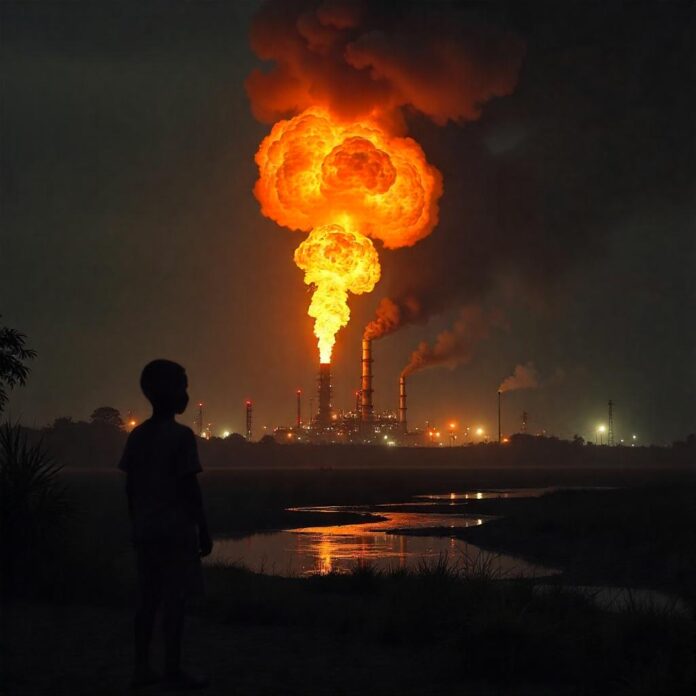The Burning Money
In Nigeria alone, oil and gas companies wasted $1.1 billion worth of gas in just five months while factories starved for energy. This startling figure represents more than financial loss—it’s a symbol of our broken relationship with energy. Gas flaring, the practice of burning off natural gas during oil extraction, isn’t just an environmental crime; it’s a lifestyle crisis affecting health, economies, and daily living worldwide. As flares light up oil fields, they incinerate resources that could power homes, stabilize economies, and protect our planet.
The Anatomy of a Crisis: What Is Gas Flaring?
The Science Behind the Flames
Gas flaring burns associated gas released during oil drilling, typically due to lack of infrastructure or economic incentives to capture it. Globally, 148 billion cubic meters of gas were flared in 2023—enough to power sub-Saharan Africa for a year. This combustion process releases carbon dioxide and toxic pollutants including black carbon and benzene into the atmosphere, creating visible flames that can be seen from space.
Flaring vs. Venting: A Critical Distinction
Flaring burns gas, converting methane into less potent carbon dioxide while releasing toxic byproducts. Venting releases raw methane directly into the atmosphere—a greenhouse gas 82.5 times more potent than carbon dioxide over 20 years. Both practices represent catastrophic energy waste, but venting constitutes a silent climate accelerator often overlooked in flaring discussions.
Why Flaring Persists: The Inconvenient Truth
Economic barriers prevent gas capture, requiring pipelines and processing plants costing over $100 billion globally. Remote oil fields in locations like Alaska and Siberia lack investment incentives. Regulatory failures enable the practice, evidenced by Nigeria’s $1.1 billion in uncollected flaring fines between 2020-2024. While safety concerns justify minimal flaring during emergencies, operators routinely exploit this exception for waste disposal.
The $1.1 Billion Waste: Financial Carnage in Focus
Nigeria’s Bleeding Economy
Nigeria lost $2 billion from flared gas in five years while failing to collect $1.1 billion in penalties. This waste manifests in soaring cooking gas prices reaching ₦1,500/kg, forcing households toward harmful firewood alternatives that accelerate deforestation and respiratory diseases. Meanwhile, factories experience chronic blackouts despite abundant energy resources burning daily.
Global Hotspots of Waste
| Country | Annual Gas Flared (BCM) | Financial Loss (USD) |
|---|---|---|
| Russia | 35.8 | $5.4 billion |
| Iraq | 18.02 | $2.56 billion |
| Nigeria | 15+ | $0.96 billion |
| Iran | 20.4 | $3.1 billion |
The Ripple Effect
Nigeria’s flared gas could generate 56,700 GWh of electricity—sufficient to power 625 million homes. Basra, Iraq loses $4.3 million daily in potential revenue that could rebuild hospitals and schools. European consumers inadvertently sustain this waste by importing 350 million barrels of oil annually from Kazakhstan, a top flaring nation.
Hidden Lifestyle Impacts: Health, Environment, and Daily Survival
Health Under Fire
Basra documented a 20% rise in cancer cases between 2015-2018 directly linked to flaring toxins like benzene. Air pollution in Iraq reaches 74 µg/m³ of particulates—15 times the World Health Organization limit—fueling asthma and bronchitis epidemics. Residents report panic attacks during intense flaring episodes, describing sensations of choking and suffocation.
Environmental Time Bomb
Flaring emits 350 million tonnes of carbon dioxide annually, constituting 5% of global oil and gas industry emissions. Inefficient combustion leaks methane equivalent to 400 million tonnes of carbon dioxide. Arctic ice melt accelerates as flaring produces 40% of black carbon that darkens reflective surfaces.
The Energy Trilemma Paradox
Nigerian factories endure blackouts while 301 million cubic feet of gas burns daily. Households pay premium prices for cooking gas as $103.9 million worth vanishes in smoke monthly. This paradox creates energy poverty amid resource abundance, forcing communities into dangerous alternatives like firewood and kerosene.
Solutions in Reach: Turning Waste to Wealth
Technical Fixes Already Working
Flare-to-power technology converts waste gas into electricity, demonstrated by Kurdistan’s Sarqala oil field generating 165 MW. Virtual pipelines transport compressed natural gas to markets, with Iraq projects aiming for 78% flaring reduction by 2025. Simple valve repairs could eliminate 4% of global flaring, while efficient burners achieve near-complete 99.84% combustion.
Policy Levers for Accountability
Nigeria’s uncollected $1.1 billion fines contrast with Kazakhstan’s strict enforcement, including $16 million penalties for unauthorized flaring. The Zero Routine Flaring initiative unites 89 entities committed to eliminating routine flaring by 2030. Europe’s Methane Performance Standard will penalize high-flaring imports by $2-3 per mmbtu.
Grassroots Power: How Citizens Drive Change
Satellite monitoring platforms publicly track 10,000+ global flares, empowering communities with evidence for legal action. Consumer demand for green-certified gas pressures companies to disclose flaring data and reduce emissions. Public campaigns successfully halted flaring projects through litigation in Nigeria and Alaska.
A Lifestyle Call to Action: Your Role in Extinguishing Flares
Daily Choices That Matter
Prioritize energy providers publishing third-party verified flaring data. A 10% reduction in European gas demand could displace 50 billion cubic meters of flared gas annually. Home energy efficiency directly reduces demand for flaring-linked products, from plastics to transportation fuels.
Amplify Advocacy
Demand legislation requiring flaring penalty reinvestment into community health funds and renewable infrastructure. Support binding methane regulations in national climate commitments. Kazakhstan’s 75% flaring reduction demonstrates regulatory effectiveness when properly enforced.
From Flares to Futures
The $1.1 billion waste represents stolen healthcare, lost jobs, and missed climate targets. Nigeria could power millions of homes with flared gas; Iraq could fund Basra’s revival with wasted revenue. Ending this crisis requires transforming conscious consumption into collective action—where every energy choice becomes a vote against waste.
Ending flaring isn’t just an environmental win—it’s a $20 billion opportunity to rebuild communities. This crisis permeates every breath we take and every bill we pay. By recognizing the human cost behind each flare, we ignite lasting change.


